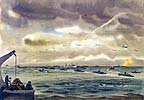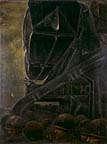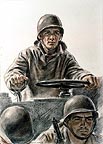 Under
the Enemy's Nose
Under
the Enemy's NoseDwight C. Shepler #145
Watercolor, June, 6 1944
88-199-ES
The Allied navies had several roles in the invasion. Underwater demolition swimmers ("frogmen") swam ashore to destroy underwater obstacles to the landing craft. Minesweeping ships combed the offshore waters for anti-ship mines. A fleet of transports carried the invasion troops across the channels, while squadrons of landing craft, skippered by Navy coxswains took them the final distance to the beaches. Divisions of battleships, cruisers and destroyers fired pre-landing bombardments to destroy German beach fortifications and "soften up" the enemy. And naval beach battalions went ashore under fire to take charge of logistical traffic on the beaches and to care for and evacuate the wounded.
 Under
the Enemy's Nose
Under
the Enemy's Nose
Dwight C. Shepler #145
Watercolor, June, 6 1944
88-199-ES
Canadian Minesweeping Squadron 31, supported by the U.S. destroyers U.S.S. Emmons (DD-457) and U.S.S. Doyle (DD-494), cleared a bombardment support lane to the Normandy coast during the night before H-Hour. The opening of the attack broke the tense silence in the scattered moonlight on Pointe-de-Hoe, while pathfinders dropped their red and green markers. All during these interminable hours of sweeping, they expected all hell to hit, but it never did.
 Opening
the Attack
Opening
the Attack
Dwight C. Shepler #149
Watercolor, April 1944
88-199-EW
D-Day morning broke over the Normandy coast to find the elderly U.S.S. Arkansas (BB-33), matriarch of the battle fleet, conscientiously banging away at the beachhead with her main battery guns. To seaward, the French cruisers "George Leygues" and "Montcalm," flying extremely large battle flags, sent shells hurtling into their captive homeland. Assault waves of landing craft streamed toward the beaches while attack transports filled the horizon. This was the way the "Arkie" was seen through binoculars from the bridge of U.S.S. Emmons (DD-457) at a bombardment station farther inshore.
 Morning
of D-Day from LST
Morning
of D-Day from LST
Mitchell Jamieson #210
Watercolor, June 1944
88-193-HI
LCIs in formation passed one after another, then executed a turn and headed in towards the coast with their assault troops. Transports and LSTs were seen in the distance. The LST to the left of the picture in the distance was unloading onto her "rhino." Overhead, a US Army Air Force P-38 fighter aircraft was hit and left the formation, trailing a stream of white smoke and flame. A cruiser and destroyer to right are shown shelling objectives ashore. The LSTs in the artist’s group had by this time unloaded their tank decks onto "rhino" forces, but it would take them hours to get in. The sea was fairly rough, making it difficult for the LSTs to "marry up" with much smaller LCTs to unload the vehicles from the main deck.
 Dawn
of D-Day Off of France
Dawn
of D-Day Off of France
Mitchell Jamieson #213A.1
Oil on canvas, circa 1944
88-193-HM
At this moment the first assault waves and demolition parties were on their way. These men, who were to go in later, could only wonder what awaited them as they stared at the distant coastline, barely discernable. The boats suspended on davits above their heads expressed oddly in their dark shapes the taut, waiting threat of this dawn off the Normandy coast. The far off rumble of explosions could be heard and mysterious processions of small invasion craft crossed the ship's bow, each with its barrage balloon, gleaming above it in the faint light, seeming to be symbols designed toward off evil spirits rather than utilitarian objects of modern war. Now and then flashes appeared fitfully on the horizon and, in the sky above, Allied fighter planes swept by angrily in groups of five and six.
Dawn
of D-Day Off of France
Mitchell Jamieson #213
Watercolor, June 19 1944
88-193-HL
Study for Dawn of D-Day
 The
Cold Dawn of D-Day
The
Cold Dawn of D-Day
Mitchell Jamieson #213A.2
Ink & wash, circa 1944
88-193-HN
Study for Dawn of D-Day
Assault
Wave Cox'n
Dwight C. Shepler #141a
Watercolor, 1944
88-199-EN
The landing craft coxswain was the symbol and fiber of the amphibious force. Exposed to enemy fire as he steered his craft to shore, the lives of thirty-six infantrymen in his small LCVP were his responsibility. If he failed in his mission of landing these troops, the strategy of admirals went for naught; the bombardment of a naval force alone could never gain a foothold on the hostile and contested shore. Prairie boy or city lad, the coxswain became a paragon of courageous determination and seamanship.
 Assault
Wave
Assault
Wave
Dwight Shepler #141b
Pastel, ca. 1944
88-199-EO
A study of the assault wave coxswain.
1 2 3 4 5 6 7 8 9 10 11 12 13 14 15 16 17 18 19 20 21 22 23 24 25